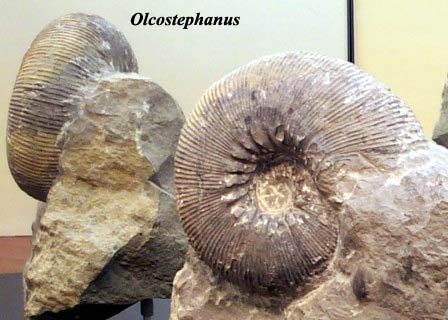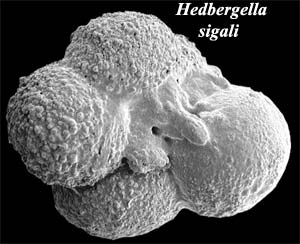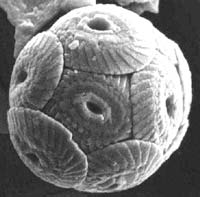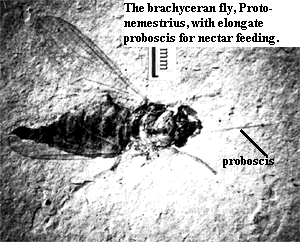
| Palaeos: Mesozoic |  |
Early Cretaceous |
| Cretaceous Period | Valanginian |
| Page Back | Back: Berriasian | Back: Late Jurassic | Up: Neocomian | Unit Home |
| Page Next | Next: Hauterivian | Next: Aptian-Albian | Timescale |
|
Cretaceous Early Cretaceous I (Neocomian) Berriasian Valanginian Age Hauterivian Barremian Early Cretaceous II (Aptian-Albian) Late Cretaceous |
The Valanginian Introduction Life |
 For
a miserable little four million year interval, less than 1% of the Phanerozoic,
the Valanginian has proven to be a complex and difficult Age. New dinosaurs emerged to rule the land, defining clades that would dominate for millions of years, such as the characteristic ornithopod herbivore Iguanodon, swiftly achieving ecological dominance, and the large and heavily armoured Hylaeosaurus, the first of the big ankylosaurs, and Dromaeosauroides, the earliest known Dromaeosaurid. Other contemporary forms like the brachiosaur Pelorosaurus and high spined theropod Becklespinax are less well known. These dinosaurs inhabited a land dominated by gymnosperms (e.g. pine forests), but a few angiosperms (flowering plants) were also beginning to appear. In lagoons and shallow coastal regions, possibly in freshwater as well, lived the small plesiosaur Leptocleidus, a late survivor of the Rhomaleosaur clade. The seas were inhabited by large
ammonoids
like Olcostephanus, bivalves
like Bruchia, and (in selected areas) some of the early rudist
reefs.
For
a miserable little four million year interval, less than 1% of the Phanerozoic,
the Valanginian has proven to be a complex and difficult Age. New dinosaurs emerged to rule the land, defining clades that would dominate for millions of years, such as the characteristic ornithopod herbivore Iguanodon, swiftly achieving ecological dominance, and the large and heavily armoured Hylaeosaurus, the first of the big ankylosaurs, and Dromaeosauroides, the earliest known Dromaeosaurid. Other contemporary forms like the brachiosaur Pelorosaurus and high spined theropod Becklespinax are less well known. These dinosaurs inhabited a land dominated by gymnosperms (e.g. pine forests), but a few angiosperms (flowering plants) were also beginning to appear. In lagoons and shallow coastal regions, possibly in freshwater as well, lived the small plesiosaur Leptocleidus, a late survivor of the Rhomaleosaur clade. The seas were inhabited by large
ammonoids
like Olcostephanus, bivalves
like Bruchia, and (in selected areas) some of the early rudist
reefs.
In fact, we know who the players were with a good deal of certainty. We also have the script. We know who was going where in an evolutionary sense. What we don't have is the scenery. That is, our knowledge of the state of the oceans, the climate and atmosphere is fragmentary and sometimes contradictory. Here's a brief run-down of what we think we know.
The Valanginian was a period of transition between the relatively cold time at the end of the Jurassic to the "greenhouse" world which continued for the rest of the Cretaceous. Unlike most of the Mesozoic, the Valanginian world was quite seasonal, and climate was regional. That is, there seem to have been distinct climate zones -- although what those climates actually were is much less certain. These climate zones are reflected in distinct "boreal" faunas in both the Northern Tethys (future North Atlantic) and Northwest Pacific provinces. These faunal regions both began to break down as rising seas created new north-south passages.
 For sea levels were rising, as they did with some consistency throughout the
Jurassic and the first half of the Cretaceous. During the Valanginian,
there were two periods of rising seas: at the very base of the Valanginian, and
during the later Valanginian. Very recently, it has been learned that
these events were accompanied by smaller-scale versions of the Ocean Anoxic
Events which began in the mid-Aptian. Black
shales, signaling deep ocean anoxia, have been found in both the Central Tethys
(Europe) and the western Pacific provinces [1]. Another similarity
to the mid-Aptian is a recently-discovered early diversification of foraminifera. Finally, there are indications of a possible temperature
spike, a milder, and possibly regional, version of the flash heating of the
oceans in the Aptian.
For sea levels were rising, as they did with some consistency throughout the
Jurassic and the first half of the Cretaceous. During the Valanginian,
there were two periods of rising seas: at the very base of the Valanginian, and
during the later Valanginian. Very recently, it has been learned that
these events were accompanied by smaller-scale versions of the Ocean Anoxic
Events which began in the mid-Aptian. Black
shales, signaling deep ocean anoxia, have been found in both the Central Tethys
(Europe) and the western Pacific provinces [1]. Another similarity
to the mid-Aptian is a recently-discovered early diversification of foraminifera. Finally, there are indications of a possible temperature
spike, a milder, and possibly regional, version of the flash heating of the
oceans in the Aptian.
Thus the Valanginian presents paradoxical indications of cold oceans and hot, regionality of climate and fauna and later globalization, essentially Jurassic oceans in some areas, with Aptian conditions in others. Its all beginning to fit a consistent pattern, but the pattern is complex.
Image credits: Olcostephanus from 3D-Fossils.com. Hedbergella sigali from the MIRACLE site of University College, London. H. sigali is actually of Hauterivian or Barremian age, but it is closely related to the Valanginian H. aptica.
Links: DinoData Timeperiods Valanginian; The Plesiosaur Site - Chronological List of Taxa -Valanginian; Geotimes - May 2004 - Outsourcing geology (Valanginian black shales); Nannofossil carbonate fluxes during the Early Cretaceous ... (more on black shales); DISCUSSION AND CONCLUSIONS (same); October 22, 2001 (and yet more); Annual Conference Abstracts 2001 (boreal Tethyan fauna); ePIC- The Greenland-Norwegian Seaway- A key area for understanding ... (boreal Tethyan fauna); 224 (same); Tauka and Zuravievka Terranes of the ... (boreal Pacific fauna briefly discussed); CCOD Abstracts (changes in plankton); Ocean Drilling Program- Leg 198 Preliminary Report (temperature spike?);
 The
transitional nature of the Valanginian shows itself only in small ways, with a
few outstanding exceptions. One of those exceptions is the first radiation
of Foraminifera. The forams had been around for some time as simple,
benthic "agglutinated" forms. Only in the Cretaceous did they
become a major component of the plankton. The first sign of this
development came in the Valanginian, with the evolution of the Hedbergellids,
such as H. sigali, shown above. A few new coccoliths, such as Watznaueria
barnesae also appeared for the first time.
The
transitional nature of the Valanginian shows itself only in small ways, with a
few outstanding exceptions. One of those exceptions is the first radiation
of Foraminifera. The forams had been around for some time as simple,
benthic "agglutinated" forms. Only in the Cretaceous did they
become a major component of the plankton. The first sign of this
development came in the Valanginian, with the evolution of the Hedbergellids,
such as H. sigali, shown above. A few new coccoliths, such as Watznaueria
barnesae also appeared for the first time.
One British marginal marine site is described in the following terms:
Invertebrate faunas included simple and compound corals, calcareous sponges and bryozoa, abundant bivalve molluscs, such as oysters, smooth terebratulid and ribbed rhynchonellid brachiopods, gastropods (snails), asteroids (starfish), echinoids (sea urchins) and crinoids (sea lilies). Microscopic organisms included foraminifera, ostracods and phytoplankton (dinoflagellates and coccolithophorid algae). Lobster- and shrimp-like crustaceans often produced burrows within sediments, preserved as trace fossils. Belemnites, relatives of the ammonites, were abundant and alongwith fish were probably the main food of the aquatic reptiles, which were the largest vertebrate animals in the sea. These included ichthyosaurs, plesiosaurs, pliosaurs, crocodiles and turtles. The fish included both holostean and teleostean bony fishes, and sharks and rays. On land, dinosaurs were advanced; mammals formed a minor but increasingly important part of the fauna. Land plants of particular prominence were the gymnosperms, notably conifers, cycads, ginkgoes, ferns and horsetails. Insect life included dragonflies. Berriasian, Valanginian, Hauterivian, Barremian - GCR block
We should add that the crustaceans weren't just lobster-like.
This was the age of the first real clawed lobsters. Bivalve
molluscs were well represented by countless species of Bruchia and Aucella,
as well as early rudists. As is usual in the Mesozoic, cephalopods
in general, and ammonites
in particular, are grossly over-represented in the fossil record. Some
representative types are: Baculites, Belemnites, and the ammonites
Thurmanniceras, Karakaschiceras, Olcostephanus, Polyptychites, and
Jeanthieuloyites -- not to mention many, many others.  Galeomorph sharks, including early
carcharinids, also appeared in the seas at this
time. However, it is obvious they had not yet learned the top predator job
very well, since we are still burdened with this interminable litany of
Valanginian ammonites.
Galeomorph sharks, including early
carcharinids, also appeared in the seas at this
time. However, it is obvious they had not yet learned the top predator job
very well, since we are still burdened with this interminable litany of
Valanginian ammonites.
On land, fern-dominated floras continued to dominate, with pine forests important in many areas, and large horsetails holding the wetlands together. However -- and here is the second major exception -- angiosperms appear for the first time in the fossil record. No fossil angiosperm plants have yet been recovered from the Valanginian, but angiosperm pollen becomes a distinct part of the terrestrial microfossil assemblage.
On and around these plants were the first oonopid spiders, caddisflies (Trichoptera), and the first advanced cockroaches. Consistent with the probable presence of angiosperms, we also see brachyceran flies, which may have been among the first pollinating insects. Ren (1998) [2]. The roaches, in particular must have been fairly numerous (why is this not surprising?) since coprolites attest to the presence of some organism which appears to have specialized for eating them.
New and old species of dinosaur overlapped in the Valanginian. We have
mentioned some of them in the general introduction. In the Valanginian, ![]() iguanodonts overlapped with
stegosaurs. Allosaurids overlapped with both Tyrannosauroids
and one of the first dromeosaurs, Dromaeosauroides bornholmensis.
In fact, all of these types co-existed in Europe during the
Valanginian! Among mammal-kind, the Valanginian was mostly the age of triconodonts. For example, Gobiconodon is Valanginian. However,
it is likely that therian mammals not only existed, but were diverging into
placental and marsupial forms. At least early representatives of both
types are found in slightly younger sites.
iguanodonts overlapped with
stegosaurs. Allosaurids overlapped with both Tyrannosauroids
and one of the first dromeosaurs, Dromaeosauroides bornholmensis.
In fact, all of these types co-existed in Europe during the
Valanginian! Among mammal-kind, the Valanginian was mostly the age of triconodonts. For example, Gobiconodon is Valanginian. However,
it is likely that therian mammals not only existed, but were diverging into
placental and marsupial forms. At least early representatives of both
types are found in slightly younger sites.
Image credits: Watznaueria barnesae from The Calcite Palace; Polyptichites from 1996-2000 University of Rochester Arctic Expeditions; Protonemestris from Ren (1998). Gobiconodon from Carnegie Online of the Carnegie Museum.
Links: Cretaceous CLIMATE-OCEAN DYNAMICS- FUTURE DIRECTIONS FOR IODP (forams); Mesozoic Mammals; Triconodonta, an internet directory (Gobiconodon); AGP, Volume 47, Number 3-4, 1997 (ammonites); Proceedings-1998 (insects); Flower (insects); Current Issue (insects); Dinosaur Genera List update #199 (dinosaurs); Another new dinosaur (dinosaurs); WEALDEN DROMAEOSAURS, JOSH TV STAR (dinosaurs); Mesozoic Mammals; Triconodonta, an internet directory (mammals); Time Line (NC) 2 (mammals).
[1] Possibly, this supports the speculation about non-biogenic, mantle-derived methane and Archeota discussed elsewhere.
[2] Ren refers to these fossils as Jurassic. The levels of the Yixian Fm. in which they were recovered have more recently been dated as Valanginian.
| Page Back | Unit Home | Page Up | Page Top | Page Next |